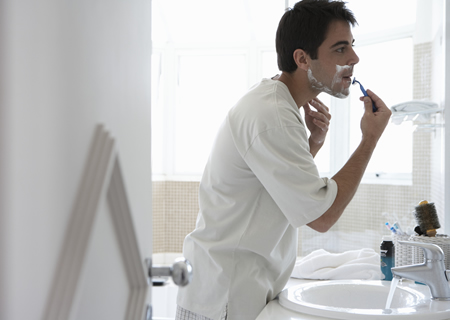Young men and the testicular cancer self-exam

contributed by Susan L. Daron, R.N., B.S.N., O.C.N., Cancer AnswerLine™ nurse
While testicular cancer is rare, it is the most common form of cancer in men ages 15-35, according to the Testicular Cancer Society. Generally men in this age group are robust and healthy, so cancer may be something they think only happens to other people. Educating men on the importance, as well as the technique, of testicular self-exam may help to reduce the incidence of this cancer.
Unlike the recommendations for breast self-exams beginning at age 20, and colon cancer screening beginning at age 50, neither the American Cancer Society nor the U.S Preventative Services Task Force recommend testicular cancer screening. The ACS says it hasn’t made recommendations because regular testicular self-exams have not been studied enough to show if they lower the risk of dying from this cancer.
However, just because it has not been studied enough does not mean that it is not beneficial. Men can benefit by learning about their bodies and what is normal for them in order to detect any changes that may otherwise go unnoticed. Monthly testicular self-exams should be even more critical for men with a family history of testicular cancer as well a personal history of undescended testicles, both of which are known risk factors for the development of testicular cancer.
Self-exam tips
Men can begin by selecting a day every month such as their birthday that will be easy for them to remember. The exam should be done in a standing position after a shower when the scrotum (sac containing the testicles) is relaxed and easier to manipulate. It involves both a visual inspection (after moving the penis to the side) in front of a mirror, as well as actually feeling each testis for any lumps, bumps, swelling, or changes. Each testis should be felt one at a time in its entirety by gently rolling it between the thumb and forefingers. It is normal for one testicle to be larger than the other as well as having one hang lower than the other.
If a man does find anything that is abnormal, it should be reported to a health care provider for further work-up. Never assume that masses or bumps will resolve on their own. It is far better to get anything suspicious checked out and have peace of mind. The Testicular Cancer Society points out, “most testicular cancers are found by men themselves or their partner, very few are found by a physician.”
Just as women are taught to focus on breast awareness, so should men be taught testicular awareness, or learning how the testicles look and feel and learning what is normal. Health providers often only see healthy adult patients once a year – or less – for 20-30 minutes, so the more one becomes familiar with his or her body, the more they can be alert to any changes. Health care providers rely on their patients to tell them of any changes or new symptoms since they last saw them. It is a challenge to do this if you do not pay attention to your body. The responsibility lies within each of us to take charge of our health though learning about our bodies.
Still have questions? Call the nurses at the University of Michigan Cancer AnswerLine. They can help patients or their loved ones find a clinical trial or provide insights into the newest and latest cancer treatments. Feel free to call at 1-800-865-1125 or send an e-mail.
